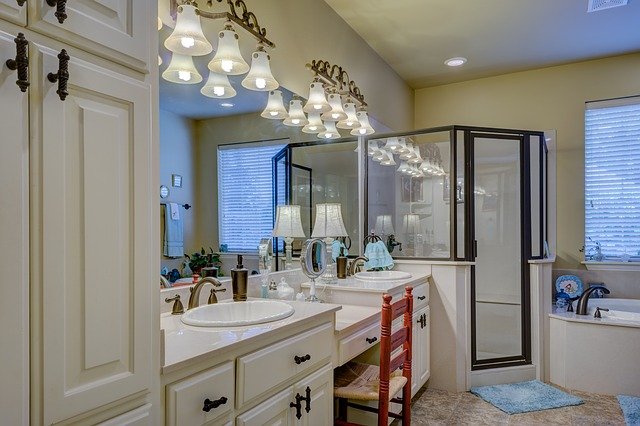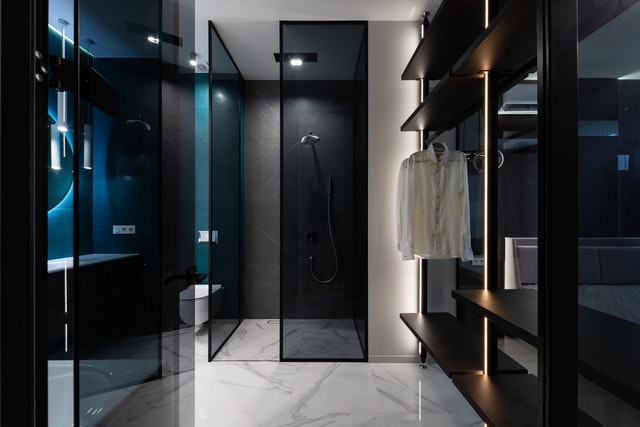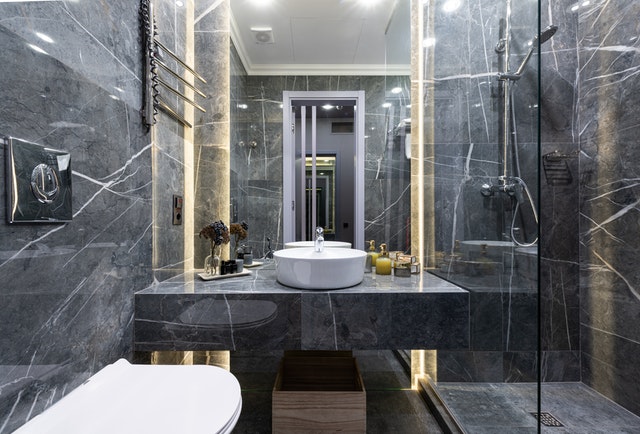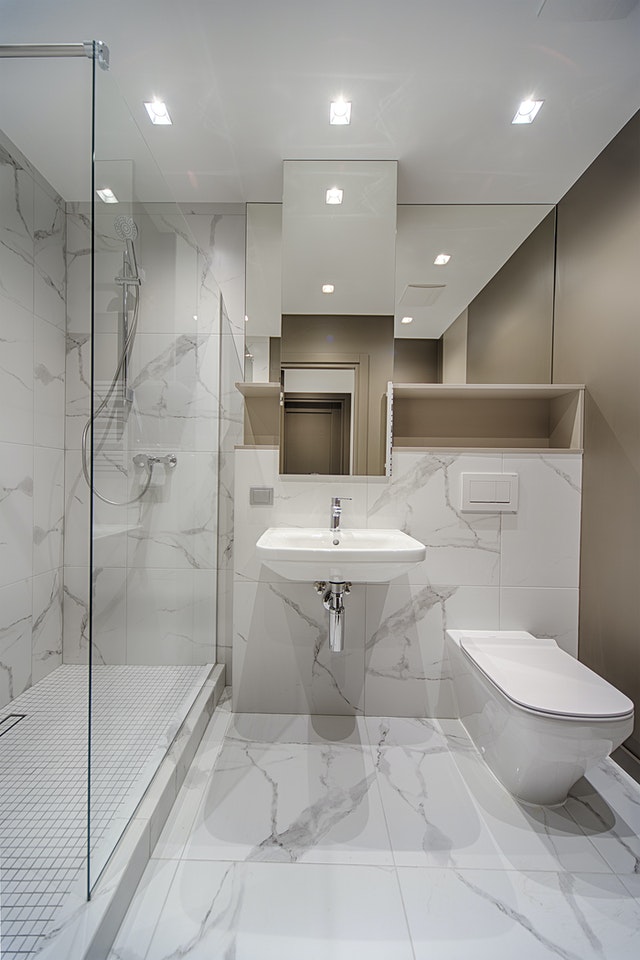Bathroom Styles
This is an excerpt from the Book called “Design Ideas for Bathrooms” by Upper Saddle River, New Jersey. Continue reading to learn more about Bathroom Styles, thanks to the author.
Get Stylish
Some time ago people said goodbye to the boring “necessary” room and happily greeted the bath of the twenty-first century, with its limitless opportunities for comfort, design, and personal expression. Restricted only by the size of their bathrooms—and the size of their budgets—homeowners are eagerly accepting these design opportunities. Whether you decorating style preferences run to traditional, nostalgic, high tech, or drop-dead glamorous, you’ll find ideas for bringing them to life in your new bath with color and other special details I the pages that follow.
- Color
- Trimwork and paneling
- Window treatments
- Style specifics
Color
Color is probably your greatest decorating tool. Don’t be afraid of it—it also happens to be one of the easiest things to change. So why do people typically stick with a neutral palette in the bathroom? A dated color on a permanent fixture can be expensive to change because usually you have to replace the fixture. However, special new paints make it possible to refurbish ceramic and porcelain with a new color for a fraction of the cost of replacement.
If you still want to stick with white or beige for the tub. Sink, and toilet, introduce color to the walls or with accessories. Just pick up a can of paint and see how color can transform the space in no time at all. If you don’t like what you’ve done, just grab another can of paint and start again. It’s inexpensive and easy to apply.
One of the simplest things that you can do to test out a color is to apply it to a sheet of white poster board, hang it on the wall, and live with it a few days. Look at it during the day; then wait for evening and look at it again under varying levels of artificial light. Is the color still appealing to you? What effect does it have on the space at different times of the day? Even if you’re thinking about tiling a wall or installing wallpaper, pick out the dominant color; find a matching paint; and apply this simple test.

Paint and wallpaper
While you’re thinking about color for the new bathroom, consider the types of paint, wallpaper, and fabric to use. Remember, bathrooms have lots of glossy surfaces, which reflect light. Unless you want an intense effect, use low-luster paints and matte finishes.
If you are concerned about moisture, especially in a room without ducted ventilation, shop for products that have been treated with mildew ide in the manufacturing process. Bathrooms are perfect breeding grounds for mold. When moisture seeps behind wallpaper, it creates a moldy, peeling mess. Luckily. This is a problem that can be avoided because there is a wide selection of products and glues that are designed specifically for bathroom applications.
Choosing patterns
After you’ve settled on a color scheme, you can look for wallpaper and fabrics to carry through your theme. Two major factors in deciding which patterns to choose are the location and size of the room. Look at the adjoining areas, especially the ones that you must pass through to get to the bathroom. Think of them sequentially. If you want stripes in the bath but the adjoining hallways has a floral wallpaper, match the colors. In a small bathroom, a bold print may be too busy. On the other hand, it may be just what is needed to make an extra-large space feel cozy. Vertical designs will add height to a room. Conversely, horizontal motifs will draw the eye around it. In general, patterned wallpaper looks best in a traditional-style décor. In a contemporary scheme, subtle patterns that don’t detract from the architecture and the materials are best. And avoid trendy looks unless you want to make changes every couple of years.
Give the room some personality
Whether you are decorating the bathroom of your master suite or a powder room, there is plenty of leeway for personalizing the space and making it truly your own. Consider your taste: perhaps you are drawn to the rich hues of Mediterranean style, such as in the room below right. There’s no reason that even a smaller room can’t be a part of a more elaborate theme. Your decorating can extend to the nooks and crannies, or you can take a more simplistic approach, as seen in the photo below left. Leave boring bathrooms for other people!
- Show it off. Small nooks can be great for displaying collections or beautiful items.
- Light it up. Think about how lighting can add to the theme of your room, in addition to where function for it.
- Share it with others. Consider guests’ needs, and what items are best to keep visible and accessible.
- Keep it current. Don’t forget to update your bath with new items to keep it current, interesting, and enjoyable.
Painting stripes
Stripes are among the most attractive painted effects you can add to a surface. Alternating broad and thin stripes, such as the ones used in the bathroom opposite top left, can go on fairly quickly and evenly. If your hand isn’t particularly steady, you may want to roll on the paint rather than use a brush to apply it. You can find narrow rollers in paint and craft shops, or you can cut down a standard-size roller to the desired width of the stripe. It’s best to use a thick paint because you have to make one uninterrupted pass with the roller. Avoid running the roller up and down.
Load the roller from a paint tray. Start at the top, a run the roller straight down (or across) the surface. For a neat look, mask the edges before applying the paint.
Trimwork and paneling
Architectural trim—a category that includes door and window casings. Moldings, baseboards, and columns—is the crowning glory of a well-planned room, like a ribbon that puts the final beautifying touches on a gift package. It’s important that you choose ornamentation that matches the style and proportions of your bathroom and the architecture of your house. Choice varies from simple to elaborate, as the drawings below illustrate. Ornate detailing works well in traditional rooms; simpler trim is more suitable for casual or contemporary settings. If you’re after a really fancy effect, you may have to enlist a trim carpenter, but check your lumberyard or home center for precut or readymade possibilities that are easy to install.

A paneled wainscot is another option for decoration. Use it to cover the lower half of the wall form the top of the baseboard to chair rail height or higher. Embellish it with molding or cap it with a wide shelf or ledge. Paneling is a way to hide minor imperfections is the wall, too. And thanks to modern engineering, some of today’s paneling products and paint primers solve the problems that traditional wood paneling often presents when it’s exposed to moist conditions.
Popular trimwork profiles
Greek and roman details are a part of so many decorating styles that it’s hard to find ornamental trim without some kind of classical design. The ogee shape, For instance, appears on everything form in tenor trimwork to exterior cornices to table edges. Here are some of the basic molding shapes and motifs that have withstood the test of time.
Window treatments
Hoose a window treatment and control system that will both enhance your comfort while in the bathroom and help create the design expression that you are seeking. You can take your cue from the climate where you live. In a hot climate, window treatments should block heavy sunlight, especially if the room faces south or west. In a cool climate. You’ll need insulated window treatments to block drafts during the winter. Especially bathroom faces north. Next consider privacy, if your bath is visible from the yard or neighboring house. Choose a device that can be easily closed to block all views to the intern. Your final selection will have to accommodate the type and size of your windows, the appearance you want and your badger of course, for the bath, it’s always best to choose easy-clear materials.
Style specifics
He bath is a place where you can express your personal style. There are no rules, but styles do fall into several categories, one of which is sure to please you. In a contemporary bath, the mood is serene; fixtures, fittings, and there is an emphasis on natural materials, such as stone, glass, and even metal. A traditional bath design relies on finely detailed cabinets in cherry or mahogany, rich; deep colors, and polished metal fittings to set a gracious and elegant tone. A country-style bath, often equipped with vintage-look tubs or pedestal lavs, is cheerier and more casual. Cottage country is casual, too, but a bit more subdued, focusing on soft pastels, faded fabrics, and gauzy curtains rather than the brighter colors of country. In both styles, however, white-painted or light cabinetry distressed furniture, wicker pieces, baskets, and framed prints figure prominently. The key to old world style is “old.” All of the elements—mellow wood and rich shades of ochre, rust red, and olive green—should look like they’ve seen a lot of use but are not yet shabby. The new take on Victorian may include period-style fixtures and fittings, but the cabinets, surfaces, window treatments, and accessories will be less fussy than in the past.


